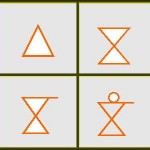In the 12th century in Karnataka there was a galaxy of Lingayat saints, the preoccupation of whom was to realize God and to remould the individual life and social institutions by that realization. The self of the cosmos and the self of man are identically the same and so are one. The self or the individual is termed Anga which is Chit-rupa, the pure conscient. The self of the cosmos is termed Linga which is Sat-rupa, the pure existent. And that Anga and Linga are one and the same is proved by the subjective mode of worship. The realization of the one Being in the objective world-process through self-awarenes is Samarasya, delight equal and equable. In the inscriptions of Mohenjo Daro and Harappa four distinct and clear terms are found to have referred to, An, Amma, Anil and Attam respectively stand for Shiva, Shakti, Sharana and Srishti.
In this article, H.H.Shri Kumarswamiji deciphers the shape of Linga to explain the complex and complete thought of God in Veerashaivism.
The word Attam, though last but not the least, is found in the inscriptions of Mohenjo Daro and Harappa. It means the lower world or phenomenal creation. An, Amma, Anil and Attam respectively stand for Shiva, Shakti, Sharana and Srishti. The shape of Linga which will be deciphered now represents the integral association of these four great terms. Attam is Aparaprakriti or Adhas-Sristi; it is the lower creation characterized by the consciousness of multiplicity. Multiplicity is the play of the one, shifting in its terms, divisible in its view of life, by force of which the one occupies many centres of consciousness, inhabits many formations of energy in the universal movement. It is this Attam upon which a Veerashaiva looks as an objective world-process, as an evolutionary process of the divine Will working through history towards ever greater and ever higher expression of delight. Wherever there is movement, life and mind are seen to be present involved or evolving. Therefore life and mind have some kind of material form as the initial condition of their activities. In this lower creation there are three principles – matter, life and mind or in more popular Indian philosophical terms – Tamas, Rajas and Sattva which, when represented by diagram, appear as a triangle. Attam or Adhas-Sristi is therefore represented by
Amma or Chit-Shakti is Paraprakriti or Urdhva-Sristi. It is the higher creation characterized by the consciousness of unity. Unity is the fundamental fact without which all multiplicity would be unreal. Multiplicity is implicit or explicit in unity without which unity would be either a void or non-existant or a state of blank repose. In this consciousness of unity al is in all, each in all and all in each, inherently by the very nature of conscious being who is Sat, Chit and Anand – existence, knowledge and bliss. Amma or Paraprakriti, who is the very soul of conscious Being, is described as Sachchidanandamayi. To represent this higher state of consciousness again a triangle is needed. But one should mark the subtle difference and the shade of meaning between Amma and Attam. Attam is Sattvarajastamomayi, while Amma is Sachchidanandamayi. Yet these are not isolated from each other, but integrally associated with this difference that the triangle which represents Amma is placed upon the triangle represented by Attam in a vertically opposite direction. When thus represented the diagram will assume this form.
Between these two creations linking them together is the world or organization of consciousness of which the intuitive truth of things is the foundation. There is a difference between intuitional idea and intellectual concept. Intellectual concept not only tends towards form but determines itself in the form of the idea and once determined, distinguishes itself sharply from all other concepts. But intuitional idea sees itself in the being as well as in the becoming. Its nature is Dristi, seeing not conceiving; it is a direct, immediate and intuitive seeing. Viewed from this standpoint the intuition of change or duration of Bergson, the stream of consciousness of James, an all-complete experience of Bradley and the religious insight of Whitehead cannot give us a vision of reality which is only presence and reveals to us as in intuition. One who has attained this Dristi or intuitive eye is called Anil or Sharana or the seer who is represented by a straight line since he runs at a tangent to the vicious circle of birth and death, to the trivial round of old habitual ideas and associations. In the third stage the diagram takes on this form . This straight line is drawn to the right side along the line representing Sat or pure existence, since the intuitive idea originates in it with an insistence on the right angle of vision.
The last that remains to be represented is An or Shiva. It is the transcendent Reality, the pure Absolute, the supracosmic Infinity. It is itself its own world, its own universe, of any other than itself it can form no concept. It knows not length nor breadth nor height, for it has no experience of them; it has no cognisance even of the number one, for it is itself one and all being is really nothing. How to represent it? Words come out baffled, it defies all definition and description. Yet the humble attempt of human mind to represent it ends in a zero. So it is represented by a zero or Shunya. And as it heads the list, the zero or Shunya is placed on the top of the diagram of the third stage. The figure in this stage then will assume this form .
This is an appropriate form of a definite and complex thought about God.
The Four Aspects of Linga as shown in above four diagrams.
This article ‘Idea of God in Veerashaivism’ is taken from H.H.Mahatapasvi Shri Kumarswamiji’s book, ‘Technique of Opening the Third Eye’.






